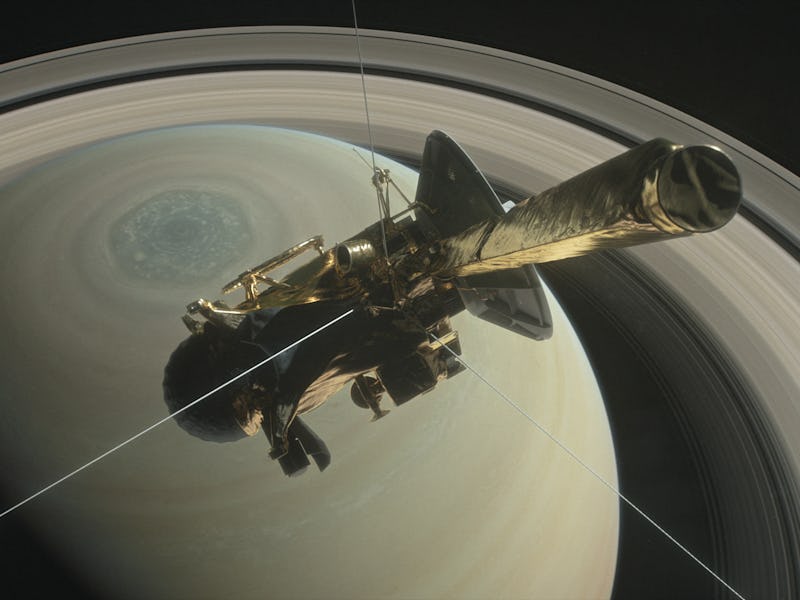How to Watch NASA's Cassini Plunge into Saturn, Ending its Journey
And what a journey it's been.

Friday is the last day of the spacecraft Cassini’s long, eventful life. Launched almost exactly 20 years ago, the probe has been in orbit around Saturn since 2004, forever redefining our understanding of the solar system’s great ringed giant. But all good things must come to an end, so it’s time for the very last stage of Cassini’s Grand Finale — and you can be there alongside the scientists at NASA’s Jet Propulsion Laboratory as they say goodbye.
NASA is ending the spacecraft’s mission by crashing it into Saturn, as otherwise there’s a risk the probe would eventually crash into and contaminate one of the planet’s moons like Titan or Enceladus. Cassini won’t get the infinite retirement of, say, Voyager 1 and 2, which will continue hurtling into the far reaches of space long after their last communication with Earth, but Cassini is being intentionally destroyed to ensure the success of future missions to Saturn.
JPL will begin the live stream at 7 a.m. Eastern Friday, with Cassini expected to send its last transmission just before 8 a.m. Here’s the video to watch along.
Putting Cassini’s journey in context is no easy task. The numbers are staggering: The spacecraft traveled just short of five billion miles, about 1.2 billion of which were during its 294 orbits of Saturn. It took more than 453,000 images and sent back 635 gigabytes of data, providing the material for nearly 4,000 scientific papers and counting.
It made 162 flybys of Saturn’s various moons, the vast majority of which were of the gas giant’s biggest moon, Titan. The spacecraft’s namesake, Giovanni Domenico Cassini, discovered four moons from 1671 to 1684: Tethys, Dione, Rhea, and Iapetus. More than four centuries later, the spacecraft brought Cassini’s discovery total to an even ten, spotting Daphnis, Aegaeon, Methone, Anthe, Pallene, and Polydeuces, as well as a few as yet unnamed moons and moonlets.
There are a pair of oceans on Titan and Enceladus respectively we only know about because of Cassini. It discovered a 5,000-mile wide hurricane at Saturn’s south pole. It zipped in between the planet’s inner rings as part of its Grand Finale. It’s hard to imagine any probe packing in more discoveries and more science than Cassini did during its 13 years around Saturn, but part of the whole point of the mission was to set the stage for future explorations — whether around Saturn or other distant planets, with Uranus and Neptune both crying out for similar close examination — that could expand on and surpass what Cassini managed.
But did it ever set the bar as high as it possibly could. If any spacecraft earned the right to end its journey in a blaze of glory, it’s Cassini.
As explained in an earlier post, here’s how Cassini’s journey ends Friday morning.
- 4:37 a.m. Eastern: The spacecraft initiates the beginning of its swan dive into Saturn, kicking off with a five-minute roll to optimally calibrate its instruments for the atmosphere. In particular, the Ion and Neutral Mass Spectrometer (INMS) instrument will make sure it’s focused directly ahead, towards the atmosphere.
- 7:53 a.m.: About 1,190 miles above the planet’s cloud tops, Cassini trudges head first into Saturn’s atmosphere at about 10 degrees north latitude, with thrusters firing off at 10 percent capacity. The spacecraft’s high-gain antenna continues to point towards Earth transmit data.
- 7:54 a.m.: Cassini’s thrusters dial up to 100 percent capacity, and the atmospheric forces of Saturn start to mess up the spacecraft’s orientation and direction — which is traveling about 76,000 miles per hour at this point.
- 7:55:06 a.m.: The mission will finally come to an end when the high-gain antenna will lose its lock on Earth. About 940 miles above Saturn’s cloud tops, communication with Cassini will terminate.
- 7:55:36 a.m.: The spacecraft will start to come apart piece by piece, burning up the same way a meteor might as it dives into Earth’s atmosphere.
- 7:57 a.m.: Cassini will be no more.